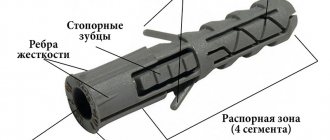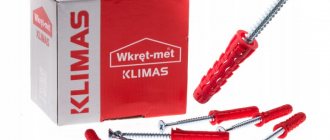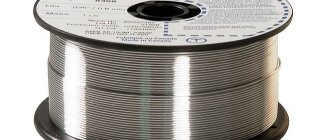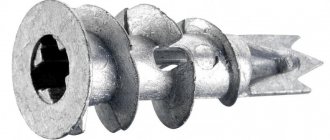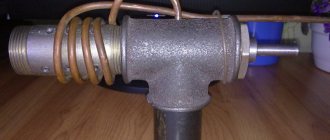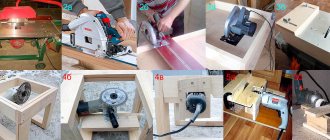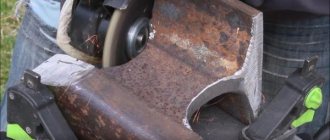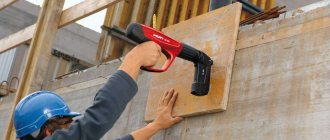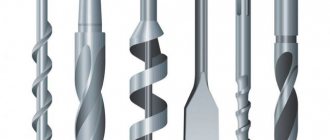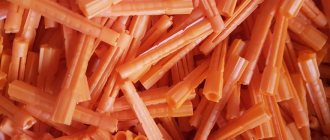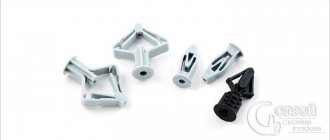What types of dowels are there?
Dowels are widely used today in all types of repairs. Fixing anything to walls, floors and ceilings is rarely complete without them. With all this, different types of dowels are used for different materials.
So, in order to hang a shelf on a plasterboard wall, you will have to buy special “Molly” dowels. For convenience and speed of working with plaster mesh, when fixing it to the wall, dowel-nails with threads, which are also very often called “quick installation,” are simply an ideal option.
Previously, the construction magazine already talked about what a dowel is. This article will talk about what types of dowels there are, and for what specific purposes they are intended.
General purpose expansion dowels
This is one of the widest groups of dowels that are used when installing furniture elements, suspended ceilings and other structures to the wall. As the name implies, fixation is carried out by expanding in the material, which means the wall must be quite dense.
Previously, instead of such dowels, wooden choppers were used. They were inserted into the drilled holes and self-tapping screws were screwed in, due to which the assembly was pulled apart and fixed. But it takes a long time to plan a chop from wood each time, so we developed expanding structures with standard dimensions for the diameter of the drills.
Description and principle of operation
For fixation, dowels of this type have moving parts that protrude outward as the screw is screwed in. The dowel itself is made of polyethylene, nylon or polypropylene. These are soft materials that are easily exposed to metal screws from the inside.
The length of the dowels can be extended, shortened or standard. There can be two, three or even four spacer blades. Some designs include a countersunk head to hide subsequent fasteners.
Expansion dowel device.
The “antennae” on the “body” of the element prevents the dowel from turning in the wall when the screw is tightened (due to a drill of the same diameter, the hole is slightly broken and without the “antennae” the plastic insert would easily rotate). The edge at the end prevents the dowel from being pushed deep into the wall.
Elements for fastening are available in standard diameters of 5, 6, 8, 10, 12,14,16 mm.
There are rare sizes of 4, 7 and 20 mm.
Difference in design
All expansion dowels have a split part, which diverges as the hardware is wrapped. The non-spacer base ensures that the integrity of the plastic structure is maintained. There may be a lip at the end to limit the insertion depth, but there are versions without it.
Expansion dowel in the wall.
All dowels in the group are also equipped with a guide cone, which ensures easier entry into the hole. According to the elements of tangential and anchor fixation, they differ into several types.
Expansion dowel with spikes
Installers call this model “chapai”. The design has serrated edges on both sides that release the fasteners in the hole. Two large spikes prevent turning until the teeth are engaged. This design is especially convenient when screwing hardware into the ceiling, when they can fall out under their own weight.
Expansion dowel with spikes.
Expansion reinforced dowel
It is most often called the “hedgehog dowel” because it has small protrusions on four sides that resemble spines. There are no long “antennae” in the design. Unlike the previous one, it expands along its entire length and is great for concrete. Due to fixation in all directions, the fastener can withstand increased loads well.
Expansion reinforced dowel.
Three-spread dowel
The model is designated as T-dowel. The spacer part contains, instead of teeth, solid, even ribs that reliably fix the fastener in the hole. The non-expandable base is equipped with conical projections that prevent the dowel from sinking into the wall. It is often used on brick and concrete to fix shelves, lamps, and paintings.
Three-spread dowel.
Application
In general, the expansion group of dowels perfectly resists shear loads, so the fasteners are optimal for walls. The weights hung on it press down, and the spacer part reliably holds the weight of up to 20-30 kg at each point. Dowels of this type are also suitable for floor installation, for example, to secure the linoleum threshold in a concrete floor. The impact from the legs is across the location of the screw axis and it does not become loose.
But when applying longitudinal force, for example, for attaching objects to the ceiling, they are not the best, since they are less resistant to pulling out. On ceilings and consoles, it is permissible to fix only light interior parts or technical devices (installation of wiring under a suspended decorative ceiling, fastening a lamp, etc.). The fixative holds well in concrete, stone, and brick.
Fastening technology
Like any other work, fixing something with a dowel is done in a certain sequence.
- Drill a hole.
- Install the dowel.
- Tighten the screw.
- Fix the desired item.
It would be a good idea to first mark with a pencil the point where you plan to make such an installation. It would be absolutely ideal to make a small hole in this place (with a knife, nail, pin, etc.), which will allow you to position the drill for the job as accurately and correctly as possible. The drill or hammer drill must be kept strictly perpendicular to the surface during operation! Under no circumstances should they be tilted at an angle.
It is advisable to clean the resulting hole from dust and cement (brick, etc.) chips, either as shown in the video above, or with a vacuum cleaner. If they are not removed, they will prevent the fastener from fitting properly.
Universal multi-sided dowels
Universal dowels are suitable for installation in different materials by density. The hardness of the base affects the method of attachment.
Description and principle of operation
The dowel design has a spacer part, but it does not just expand slightly, but is capable of folding in the area of the opposite end. Thanks to this, a counter stop is created that reliably holds the fastener and the piece of furniture hung on it.
The holding method depends on the density of the wall material. If the wall is solid, then the expanding part moves apart until it stops and is held in place by friction forces. With a hollow wall, the base goes right through, and due to the deformation of the second edge (bent at an angle of 90 degrees or tied in a knot), an anchor is formed.
Difference in design
There are two types of universal dowel configurations - folding and twisting. The first attracts the plastic strips as the metal pin is screwed in. This creates a persistent crossbar that prevents the fasteners from coming out or knocking out part of the wall.
Multi-sided wall plug.
Folding multi-sided dowel.
The second one has a plastic insert that is screwed into a knot when the threaded element rotates. This leads to the formation of a large seal on the reverse side, preventing the movement of the screw. The first type of dowel can be unscrewed back if desired, but the second type cannot.
Twistable dowel in the wall.
Twistable dowel.
Application
Universal dowels are applicable everywhere where expansion dowels are used. Moreover, they will be able to catch where spacers would simply jump out (for example, in hollow materials). Due to the formation of a large stop on the reverse side, universal dowels adhere better to the ceiling. But they are inferior in terms of load-bearing capacity, and it is undesirable to hang heavy hanging tables, cabinets and other objects on them.
Most often they are used for fixation:
- wooden blocks;
- metal slats;
- parts from suspended ceilings;
Fastening methods
In our time, abundance has affected many areas, and construction is no exception. The variety of materials and tools would have amazed any man who lived one hundred to two hundred years ago. Many works can be performed not only by professional builders or workers, but by any person who has the need and desire to learn how to do something. Let's look at the popular types of fasteners regarding the base material.
Concrete, brick
Many fastener options are designed to work with dense base materials. Expansion, universal, nail - all these dowels in dense, heavy concrete or brick will sit firmly, press firmly against the wall and create the necessary friction force.
The dowel-nail is deservedly often called “quick installation”; it is very popular. Everything is simpler here and it will take significantly less time. You need to drill a hole (for example, when installing baseboards), insert a dowel-nail, use a hammer - and it’s done. Attention! This fastener has a nail head with slots for a Phillips screwdriver, but it does not need to be screwed in, this is for possible dismantling. Let's hammer it in, don't be shy!
Foam concrete, aerated concrete
In hollow and loose materials it is impossible to achieve such tight, reliable contact as in concrete, for example. For a strong grip, dowels are used that will ensure reliability due to their shape. Such fasteners include: universal, screw-on, drive-in elements.
Read also: Lubricator in the oil industry
The universal element in the hollow material forms a complex configuration that will prevent the screw/screw from falling out. The dowel does not expand (as in concrete, for example), but twists intricately and subsequently acts as a stop.
Panel and sheet materials
There is a peculiarity of the material here - a narrow sheet, behind it there is emptiness. There are two types of dowels for such materials: “molly” and butterfly dowel. They act the same. “Molly” is made of steel and is suitable for heavy loads (up to 75 kg), “butterfly” is made of plastic and can withstand weight up to 30 kg. Let's talk in more detail about the last type of fastener.
A gentle name is given to this fastening device for its appearance, vaguely reminiscent of a butterfly. The main condition is the appropriate width of the material. An important feature of this type of fastener is that during the screwing process it is compressed, special inserts are pressed against the back wall of drywall or other material. Thus, there is a uniform distribution of the entire resulting load on the sheet.
In conclusion, I would like to wish you not only to choose the right drill for the dowel, but also to get maximum pleasure from the construction process!
In accordance with applicable law, the Administration disclaims any representations and warranties that may otherwise be implied and disclaims liability in relation to the Site, the Content and its use. More details: https://seberemont.ru/info/otkaz.html
Was the article helpful?
Tell your friends
A drill is a cutting type tool designed to make holes. The mechanism of operation of the drill is simple - the product rotates around its longitudinal axis and at the same time moves forward, cutting into the material. The spiral configuration of the drill ensures that waste is removed from the working area while helping to cool the tooling.
Types of dowels for drywall and other thin-walled materials
Thin-walled materials include: gypsum fiber boards, particle boards, plasterboard sheets and others. A regular expansion dowel cannot be fully secured in them due to the low density of the base and shallow depth.
Such panels are often used for decorative wall cladding, insulation or installation of partitions. To hang a picture or shelf on such a base, you can use universal fasteners. But it is better to resort to a variety of dowels designed specifically for thin-walled materials.
The most common are “butterflies” with different design variations, available from many manufacturers. The transformable part can be made of either plastic or metal. The general principle of operation of the dowel is to form a massive stop on the reverse side, due to which the element is securely held in the wall.
For this:
- the thin wall base is passed through with a drill;
- insert the dowel;
- tighten the self-tapping screw.
As it deepens, the thread tightens the far end, expanding the edges of the supporting crossbar.
Other versions of drywall anchors have a one-piece design and are held in place by tall threads. Some can be unscrewed if necessary and installed in a new location, others can be mounted only once and forever.
According to the characteristics, dowels in this category are divided according to wall thickness, but most often they are produced in one size. Then the latch on the reverse side can move completely or partially.
Another parameter is the diameter of the dowel with a “shirt”. The choice of drill for making a hole depends on it. There are types of dowels that can be installed without pre-drilling, which increases productivity. Let's look at each type in more detail.
Dowel butterfly
The fastener was named because of its similarity in shape to butterfly wings. It consists of two parts - a metal screw and a plastic “shirt”. The latter is made of nylon and contains a non-expanding part with a side and a counter end with a thread. Between them there is a folding part, which is additionally reinforced with sliding partitions.
Butterfly dowel.
As the screw is screwed in, the ends are attracted to each other, and the longitudinal ribs become perpendicular, forming a large stop on the reverse side.
Butterfly dowel in a plasterboard wall.
In order for the plastic part to open, the length of the screw must be at least 55 mm. Only in this case will the plastic part open completely. The dowel can be unscrewed and re-tightened. Reliability of retention is not lost in this case.
Use it to attach to drywall:
- cornices;
- chandeliers;
- slats;
- shelves;
- antennas.
Dowel Driva
This is a type of dowel without a flared part. It consists of two elements installed in series. The first is a cone with a helical thread. It can be made of plastic or metal.
Wood dowel made of plastic.
Metal dowel.
The part is inserted into a pre-prepared hole by screwing it in with a special attachment. There are versions with a drill at the end, thanks to which installation occurs without pre-drilling.
Driva dowel with drill.
Due to the high thread turns with a wide pitch, reliable fixation is achieved in the hollow material. A slight protrusion of the element onto the opposite side of the panel is allowed.
Wood dowel in the wall.
The second part of the dowel is a steel self-tapping screw that is screwed into an already installed base. With its help, paintings, frames and other not very heavy objects are attached. The dowel is easy to dismantle if you need to remove the installed elements. When both parts of the dowel are metal, it can even be screwed into chipboards, which have a higher density compared to plasterboard.
Dowel Molly
The most reliable type of drywall dowels is “Molly”. It is made only of metal. This is galvanized steel, which has excellent corrosion resistance, so the fasteners do not deteriorate even in damp rooms. The dowel has a hollow collet with a supporting edge. It has teeth that protect the fasteners from turning. Such fasteners are classified by diameter and length, which is important to consider when choosing a specific thickness of plasterboard sheet.
Dowel Molly.
Installation is carried out using a drill, and then:
- A hollow collet is inserted into the prepared hole.
- Using a special gun, it is pushed apart using a lever method from the reverse side.
- The tool is removed and a screw is inserted into the hole with a metal edge. It just screws on the thread.
If necessary, the screw can be easily unscrewed and reinstalled. The load-bearing capacity is not lost.
Molly dowel in the wall.
One Molly dowel can withstand a load of up to 25 kg, so they are actively used for hanging kitchen furniture, chandeliers, lamps, cornices and shelves.
The screws in Molly dowels come with a countersunk head (so as not to interfere with the installation of other overlapping panels) or with a spherical head (when the mounting eyes are located on top of the furniture or inside the cabinet).
Which fastening hardware to choose for certain types of material
Modern manufacturers make furniture not only from chipboard, but also from other materials.
Thanks to the wide range of fittings, you can choose fasteners for any type of furniture
Table 6. Selection of fasteners based on the furniture material.
| Material | Description |
| Glass | Fasteners such as self-tapping screws (of the “quick installation” type) are used, which are screwed into the wall. Usually this is a thin self-tapping screw with a plastic attachment. Also, fasteners can have a special adhesive composition and a rubber gasket. They provide fixation of shelves and glass surfaces, while the furniture coating is not damaged. Glass doors on a cabinet can be installed using regular furniture hinges. |
| Metal | Screw fasteners are ideal for connecting metal parts. They can be fixed to the stand using a screwdriver/drill. To prevent the furniture from losing its aesthetic appearance, the head of the fasteners can be closed with a plug. |
| Plastic and chipboard | To fix such furniture, you can use any fasteners that are designed for chipboard. |
Dowels for aerated concrete and other porous materials
Aerated concrete, unlike drywall, is voluminous and thick, but contains many voids within its structure. Multiple engagement points are required for secure fixation. Here are the main types of dowels suitable for such material.
Dowel with cutters
The sleeve is made of sheet iron. The working surface has four expanding edges, covered along the entire “body” with cutters. When screwing in the self-tapping screw, the steel teeth seem to “bite” into the aerated concrete and prevent the fastener from moving outward.
Dowel for aerated concrete with cutters.
For reliable installation, it is necessary to correctly select the diameter of the drill so that the dowel does not dangle in it. In this case, the four working edges with cutters will prevent rotation along the axis and will reliably open up. But the product cannot be dismantled, since the metal takes on an expanded shape and does not move back, which means the installation location must be carefully verified.
Dowel for aerated concrete with cutters in the wall.
Dowel with screw ribs
The model is marked GB. It is a plastic conical tube with a cut and solid ribs protruding along the entire structure. They are located with a slight overlap in the spiral, so they rotate slightly at the moment of driving. Due to the long, rounded ribs, the load is evenly distributed over the entire circumference and the dowel sits securely in the aerated concrete wall.
Dowel with screw ribs.
The plastic sleeve can accommodate screws with a diameter of up to 28 mm. Such elements have approval from the German building supervision organization and are suitable for preliminary or permanent installation in aerated concrete.
Dowel with screw ribs.
The length of the screw is calculated by adding the length of the dowel itself, the thickness of the mounting eye and another diameter of the screw. The element is even suitable for fixing into unplastered walls. When installing, it is important to use the drilling mode without impact, otherwise the hole will be too loose and weaken the fixation.
Metal dowel with internal thread
The dowel is made of metal and has high turns of external thread. Due to this structure, it is well retained in the porous material and resists not only shear loads, but also longitudinal effects.
Metal dowel with internal thread.
Installed in a pre-drilled hole using a hex wrench using the rotation method. For large volumes of mounting elements, it is advisable to use a screwdriver or drill at low speeds.
The dowel has proven to be resistant not only to static but also to variable loads, for example, holding shelves, shoe stands, and kitchen hanging cabinets. Since the part is entirely made of metal, it provides increased fire resistance and can be used near heating sources (it is allowed to hang heating radiators or fireplace protective screens on such dowels).
Based on the base materials, the dowel is suitable for:
- solid and hollow light expanded clay;
- solid porous concrete;
- ordinary expanded clay.
What is it and what is it for?
Dowel fastening is a method of mounting various objects or structures to monolithic hard surfaces - this is its purpose. It works great on concrete, brick or stone surfaces and can also be used on drywall and ceramics. Externally, a dowel-nail looks like a device that combines 2 components: a dowel structure made of plastic and a screw. The design of certain types of dowel frames has a limiter made in the form of a cuff, which is necessary so that when driving the dowel into the wall, the device does not sink into the prepared hole. The limiter can be of various modifications - round, in the form of a cylinder or a hidden type.
You can install dowel fasteners inside the wall using a hammer, and the installation process is simple and does not take much time. This fastening option is used for mounting plasterboard systems, for installing baseboards or cable ducts, hanging shelves, cabinets and much more. The dowel-nail performs reliable fastening only in strong monolithic structures; it is not advisable to use it for cellular concrete or hollow brick.
Frame dowels (facade)
This is the most heavily loaded type of fastener with plastic elements. The model should not be confused with frame anchors, where the “shirt” is also made of metal. The frame dowel uses a plastic sleeve of complex shape and a screw of increased thickness. This allows you to hang particularly heavy parts on the fasteners, eliminating gradual subsidence in the material.
Description and principle of operation
Frame dowels have “whiskers”, teeth and moving parts that stick out to the sides as the screw is turned. The steel element is equipped with a low-profile thread and is produced 10 mm longer than the plastic counterpart. The screw is tightened with a screwdriver, screwdriver, star wrench, and in the largest versions of the dowel, with a spanner.
The model is available in different lengths up to 100 mm, so it is well fixed in numerous places, even when installed in “weak” materials with pores or technical voids. The product is suitable for through installation. The increased dimensions of the fasteners contribute to an increase in the fixation area.
Difference
According to their configuration, frame dowels are conventionally divided by the number of spacer zones. There are one or several such rising plates. The plastic sleeve has comb tracks or single triangular ribs. An expansion zone is provided both next to the cone and closer to the base, which prevents the dowel from loosening in a fragile material with voids.
Application
Due to the design with an increased cross-section of plastic and metal, as well as a more elongated non-expanding part, the frame dowel is suitable for fixing heavy building materials. It is used during installation:
- wooden beams and slats;
- door frames;
- window frames;
- large-diameter communications (for example, sewer pipes);
- brackets and tires;
- façade laths.
The steel element sits securely in the plastic part and resists shearing or bending forces. Since the fasteners provide for through installation, the product always has a collar that protects it from falling into hollow materials. The head can be either hidden for inserting the screw flush or protruding.
Tips for choosing
To choose the right dowel-nail, you need to understand what load the fastening will have to withstand and what it will be intended for. Most often, dowel fasteners are used to work with concrete material in the form of a dense monolith. Let's consider the recommendations of specialists in the selection of fasteners.
- If you need to hang kitchen cabinets or other objects with quite a lot of weight, then you need to stock up on fasteners, the length of which will be at least 85 mm.
- When making fasteners for plinths, for cable ducts, for insulating walls with one material or another, as well as for fixing structures located horizontally, the length of the dowel fastening is selected from 30 mm, and its diameter is taken from 6 to 10 mm.
- For the installation of a suspended ceiling, as well as for PVC structures or the installation of lighting devices - in a word, for those products where the load comes from the lower part of the structure, dowel fastenings are used, which have spacer antennae or notches applied to the working body.
- If you need to select a dowel fastener for a ready-made hole in the material, you should remember that the size of the diameter of the hole and the dowel fastener must be equal. If the diameter of the hole is larger than that of the dowel, high-quality and reliable fastening will not work, since the dowel will become loose and come out over time.
- In walls made of foam concrete, dowel fastening can become a kind of softening cushioning material. In this case, it is necessary that such fasteners be tightly fixed in the material, and the load of the weight of the structure being held is evenly distributed over all fastening units, that is, over the remaining dowels.
Disc-shaped dowels (fungi, umbrellas)
These are special-purpose dowels with an enlarged plate-shaped head. It increases the clamping area of the fixed material. The diameter of the fungus is possible from 45 to 90 mm. The cross-section of the nail itself is 8 and 10 mm. From the outside, the fasteners are usually covered with finishing materials, such as plaster, and therefore do not affect the design of the building.
Description and principle of operation
The dowel consists of a large plate that distributes the load from the received material more evenly. Since it is used to fix fragile insulation (foam plastic, mineral wool, etc.), the large area of the cap prevents it from breaking through. Installation of fasteners is carried out using a hammer drill, which makes a hole in the wall. Then insulation is applied and a dowel-fungus is inserted through it.
Disc-shaped dowel in the wall.
Fixation is achieved by driving a long nail that pushes the plastic sleeve apart. In this case, it is important not to drill the hole for the dowel very deeply, otherwise there will be a depression on the surface of the insulation. An umbrella on a leg perfectly holds soft material, preventing both displacement along the wall and detachment from it.
Difference
Umbrella dowels are available with or without expansion washers. This additional element fixes the insulation even more reliably.
Disc-shaped dowel with expansion washer.
In addition to wall dowels, they produce fungi for installing roofing materials. In this case, the nail is driven into the concrete (ceiling) and can hold corrugated sheets, ondulin, roofing felt and other sheet panels.
The large cap prevents water from flowing into the mounting hole. With this type of dowel, the plastic umbrella contains three large spikes that prevent movement. The conical part makes it easier to insert the plastic sleeve into a pre-prepared hole.
Dowels for insulation are divided into the following types:
1. With a plastic nail. There are no metal elements in this design. Plastic perfectly tolerates temperature changes from -40 to +80 degrees. The fastener can withstand impacts of 20-380 kg/m². Plastic retains heat transfer better, which is beneficial when installing insulation.
Due to their low cost, most buyers prefer these dowels, but they are not suitable for fixing thick insulation.
Dowel with plastic nail.
2. With a metal nail. A similar design, only the expansion nail is made of galvanized steel. The holder does not rust and can withstand loads of up to 750 kg/m². This is a more reliable way to connect soft insulation and the wall, but cold also passes through the metal. The cost of dowels with steel nails is higher.
Dowel with metal nail.
3. With thermal head. The metal nail head is complemented by a plastic tip. It serves as an insulator and slows down heat transfer. With such a thermal head, the dowels are the most expensive, but the best in quality.
Dowel with a nail with a thermal head.
Application
Umbrella dowels are optimal for fixing mineral wool slabs to walls with subsequent covering with decorative panels. They are used when attaching strips of sheet insulation. They have proven themselves to be good at holding foam boards with a thickness of 25-50 mm. Subsequent plastering completely aligns the attachment points with the general surface and hides them.
Type and purpose of tools
In order for a drill to be as efficient as possible, you need to select it correctly, taking into account the properties of the material being processed, the requirements for hole sizes and the characteristics of the equipment. Manufacturers produce drills of many types, but they are all divided according to their scope of application into three main types:
- Machine tools (machine);
- Locksmiths;
- Construction.
Drills also differ in design. It is customary to distinguish between conical drills and twist drills. The last type of tool is the most common - twist drills are most in demand for use with drilling machines and hand-held power tools. In construction, the most popular are drills with special tipped hard alloys, which allow working with stone, brick and concrete. We'll talk about them today.
Types of dowels based on material of manufacture
Although there are dowels with metal sleeves, most often this type of fastener is made of plastic. It is more affordable and does not require complex equipment with high heating temperatures to melt and give the desired shape. There are three types of plastic available.
Polyethylene (PE)
It is a product obtained by the polymerization of colorless ethylene gas. During the crystallization process, a dense plastic mass is formed. The structural formula of polyethylene belongs to saturated hydrocarbons and contains (-CH2-CG2-)n.
The substance tolerates exposure to negative temperatures down to -40 degrees. The plastic is quite durable, has high viscosity and does not absorb water. The material does not dissolve under the influence of gasoline, oils, acids, alkalis and alcohols.
Disadvantages include susceptibility to aging, a tendency to crack at too low temperatures, and destruction from aromatic hydrocarbons, as well as chlorinated hydrocarbons.
Polyethylene dowel.
Polypropylene (PP)
It is a derivative of ethylene. The structural formula classifies it as a saturated hydrocarbon and looks like this: (-CH2-CH(CH3)-)n. The material serves well at elevated temperatures up to +80 degrees, but is not so good in cold weather. Susceptible to aging and cracking. Under normal conditions, it is not brittle and hard, and does not absorb water at all.
Polypropylene can withstand prolonged contact with acids, alkalis, alcohols and saline solutions, but it also deteriorates from chlorinated hydrocarbons. This substance also allows odors to pass through.
Polypropylene dowel.
Selection rule
This rule is simple and sounds like this: the diameter of the drill is equal to the diameter of the dowel. Relative to its length, it is 3–5 mm longer than the fastening element. This ratio will be optimal. All instruments are marked accordingly. If you want to measure manually - with a caliper, for example - remember that you need to measure the soldering from pobedit, the tool itself is narrower.
Read also: How to find parallel resistance formula
Why do we take a drill longer than the fastener? It's simple - we leave space for dust and crumbs formed during drilling. You also need the screw or self-tapping screw to go beyond the dowel. Then the grip will be maximum and your skill will be at its highest level.
In the video you can see how to insert the fastener into the wall and remove the dust generated during the work.
Features of using dowels
When choosing a dowel, it is not enough to focus on its shape; it is also important to know what size (length, diameter) to choose. For each working surface it is necessary to select its own fasteners. The “six” dowel (6*40) is suitable for installing profile structures in cinder block houses. By choosing a different size, it will not be possible to make repairs, since all the fasteners will simply fall out of the drilled holes.
For panel houses (as well as those where there are no voids in the walls), the best option for dowels is 6*60 or 6*80. With them, everything will be securely fastened, nothing will fall through or fall out even on the ceiling.
When choosing the length of the dowel, it is worth remembering the load that the fastener will be subjected to in the future during operation. The shorter the dowel and self-tapping screw, the less load it will withstand. The diameter is also important. For ordinary housework (hanging a cabinet, mirror or wall unit), dowels with a diameter of 8-10 mm are sufficient. The only difference is the depth of the hole being drilled, since the load on the dowel is different.
For a cabinet, 3-5 cm is enough, and for a wall unit or a heavier cabinet or shelf - 8-10 cm. Another important question that arises before the master is what kind of drill is needed for the dowel. To answer this, you first need to know what surface will be drilled and what load on the structure is planned in the future after the work is completed.
Installation
Installing a metal dowel is no different from installing a plastic one, except for those cases when the fasteners are driven into the base without drilling holes. As in all similar cases, the difference in fastening is provided not by the dowel itself, but by the base material.
Calculation of dowels
The simpler the installation - a single fastening, for example, the easier it is to determine which dowel is needed and in what quantity. With complex fastening on a poor base - porous concrete, stretched concrete, it is more difficult to calculate the required amount.
When making calculations you should take into account:
- type of fastener - frame dowel is absolutely not suitable for hanging a chandelier, since it is intended for a completely different load;
- type of material - for aerated concrete, sand-lime brick, hollow clay or plasterboard it is necessary to use different types of fastening. Moreover, it is necessary to take into account not only the type of material, but also its period of use. Thus, old concrete, especially those with cracks, will not be able to hold the fasteners as firmly, which means that when calculating the workload, the workload will have to be reduced;
- axial distance - a metal dowel creates considerable stress in the base material, so you cannot thoughtlessly attach it close to the edge or axis. Data on permissible edge and axial distances is in the product passport;
- working load - must be indicated in the certificate, as well as the maximum permissible for different types of bases;
- place of installation - a dowel installed in the ceiling is subjected to maximum pull-out load, but experiences almost no shearing force. The latter has a strong effect on the fasteners fixed in the wall, along with the pull-out load. In addition, the fastener is also affected by the torque that occurs when screwing in the screw. In this regard, the characteristics of products usually indicate how many revolutions the fastener can withstand.
Technology
The sequence of action is the most common. There is some difficulty in forming the holes.
- To ensure reliable fastening, the diameter of the hole must coincide as much as possible with the diameter of the dowel, and when using a hammer drill, for example, or a drill with an impact function, and even in dense material, the drill forms a hole with a larger diameter. During installation, it is advisable to disable the hammer function of the drill. A hole is drilled in the brick with a drill: first at low speed to avoid cracks, then at high speed. The depth of the hole is 10 mm greater than the length of the product.
- In concrete, the attachment point is marked with a center punch and punched through with a hammer drill. The depth of the hole is 5–6 mm greater than the length.
- A hole is cut on the tile with a metal drill - only the top layer, and then drilled out with a drill.
Installation is done somewhat differently using a gun. In this case, the holes are not pre-drilled, and the dowel is driven directly along the marked line through the layer of material being fixed.
Expansion dowel with metal rod
Price of work and material
The dowel is an incredibly popular fastener, so it is produced by almost all construction companies. Well-known manufacturers of anchors, for example, Fischer, Sormat, Koelner, METAL PROFIL, also produce all possible types of dowels. For example, Fischer also has a metal expansion dowel FMD. Their cost is determined by the material, size, and design features.
- A driven dowel-nail costs from 4 to 6.6 rubles. per piece
- The cost of a frame dowel with a single spacer zone ranges within the same range - 4-6 rubles, but German-made fasteners - from Fischer, with two spacer zones - are priced more expensive - 24 rubles. per piece
- 100 pieces. Molly fasteners of Chinese origin cost from 512 to 665 rubles. The domestic version costs around 854 rubles. for 100 pcs.
- Fasteners for drywall and porous concrete with spiral ribs are priced from 86 to 189 rubles. for 6 pcs.
Since fastening with dowels is a standard procedure, it is included in the cost of the installation itself. Only the fastener itself can be a separate item, if it turns out that special products are needed that were not provided for at the planning stage.
Metal dowels are a common type of fastener, but have a higher load-bearing load due to a more durable material. It is used for all types of surfaces when it is necessary to secure a massive structure.
This video will tell you about a dowel for insulation (thermal insulation) with a metal nail:
Specifics
The metal dowel is a universal dowel. Its peculiarity is the ability to withstand significant loads even in a structure of small thickness.
As can be seen from the photo of the metal dowel, in appearance it is a hollow steel or brass cylinder that expands when a nail is driven into it. The reliability of the fastener is ensured by the tight fit of the dowel walls to the hole.
The role of the second component of the fastening element can be played by a special self-tapping screw, an ordinary nail or a screw. In other words, you can use any hardware with the exception of anchors in combination with a metal dowel.
Both ready-made dowel-nails and dowel-screws are sold, as well as just individual dowels. When selecting the second part of the fastener, you need to take into account the size of the intended load and the characteristics of the dowel.
How to choose a drill for a dowel
The most important rule is that the drill number must match the number (size) of the dowel. That is, ideally, the dowel should be driven into the wall with difficulty, otherwise, a situation is possible when the dowel simply falls out or fails. As for the quality of drills, experienced craftsmen advise using pobedit ones, since buying more expensive ones does not make much sense. Making a hole for a dowel is easy (for example, take dowel 10):
- First, take a smaller drill bit, such as an 8-point drill. Make the hole slightly smaller in depth than necessary using the impact mode.
- Then you will need a drill that is the same size as the dowel, that is, a 10-piece. Turning off the impact mode, finish the desired hole.
By following these rules, you will do everything without problems.
